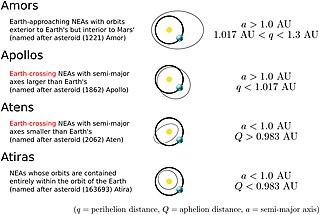
The Aten asteroids are a dynamical group of asteroids whose orbits bring them into proximity with Earth. By definition, Atens are Earth-crossing asteroids (a < 1.0 AU and Q > 0.983 AU). The group is named after 2062 Aten, the first of its kind, discovered on 7 January 1976 by American astronomer Eleanor Helin at Palomar Observatory. As of November 2023, 2,646 Atens have been discovered, of which 256 are numbered, 14 are named, and 102 are classified as potentially hazardous asteroids.

Atira asteroids or Apohele asteroids, also known as interior-Earth objects (IEOs), are Near-Earth objects whose orbits are entirely confined within Earth's orbit; that is, their orbit has an aphelion smaller than Earth's perihelion, which is 0.983 astronomical units (AU). Atira asteroids are by far the least numerous group of near-Earth objects, compared to the more populous Aten, Apollo and Amor asteroids.
(434326) 2004 JG6, provisional designation 2004 JG6, is an eccentric, sub-kilometer sized asteroid, classified as near-Earth object and potentially hazardous asteroid of the Atira group. It is one of the closest orbiting objects to the Sun. While its perihelion lies within the orbit of Mercury its orbital trajectory is highly elliptical, causing its aphelion to cross the orbit of Venus. Therefore, it does not fit the criteria for a vulcanoid or ꞋAylóꞌchaxnim asteroid, which would require it have a wholly intra-Mercurian and intra-Venusian orbit respectively.
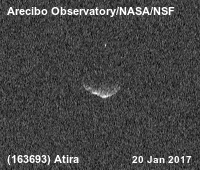
163693 Atira (; provisional designation 2003 CP20) is a stony asteroid, dwelling in the interior of Earth's orbit. It is classified as a near-Earth object. Atira is a binary asteroid, a system of two asteroids orbiting their common barycenter. The primary component with a diameter of approximately 4.8 kilometers (3 miles) is orbited by a minor-planet moon that measures about 1 km (0.6 mi). Atira was discovered on 11 February 2003, by astronomers with the Lincoln Near-Earth Asteroid Research at Lincoln Laboratory's Experimental Test Site near Socorro, New Mexico, in the United States.
(459883) 2014 JX55 is an asteroid from the central regions of the asteroid belt. After its first observations as 2007 EB26 in 2007, it was considered an inner heliospheric asteroid and near-Earth object with one of the closest perihelions ever observed of any body orbiting the Sun, until further observations invalidated the conclusions from early observations. The object measures approximately 2.8 kilometers (1.7 miles) in diameter.
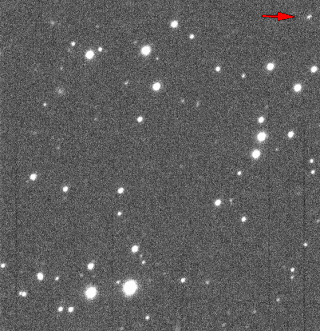
(511002) 2013 MZ5, provisional designation 2013 MZ5, is a sub-kilometer asteroid, classified as a near-Earth object of the Amor group, estimated to measure approximately 300 meters (1,000 feet) in diameter. It was discovered on 18 June 2013, by astronomers with the Pan-STARRS survey at Haleakala Observatory on the island of Maui, Hawaii, in the United States. It was the 10,000th near-Earth object ever discovered.
(456938) 2007 YV56, provisional designation 2007 YV56, is a sub-kilometer asteroid on an eccentric orbit, classified as a near-Earth object and potentially hazardous asteroid of the Apollo group, approximately 190–360 meters (620–1,200 ft) in diameter. It was discovered on 31 December 2007, by astronomers of the Catalina Sky Survey conducted at the Catalina Station in Arizona, United States.
1993 DA is a sub-kilometer asteroid, classified as a near-Earth object of the Aten group. It has only been observed during 5 days in February 1993, and not been detected ever since. The small body measures approximately 20 meters in diameter based on an absolute magnitude of 26.4, and has an Earth minimum orbital intersection distance of 13.8 lunar distances or 0.0355 AU (5,310,000 km).
2017 SX17 is a very small asteroid, classified as a near-Earth object of the Apollo group, approximately 6–12 meters (20–40 feet) in diameter. It was first observed by astronomers of the Mount Lemmon Survey at Mount Lemmon Observatory on 29 September 2017, three days prior to its sub-lunar close encounter with Earth at 0.23 lunar distances on 2 October 2017.
2010 GZ60 was originally estimated by JPL to be a near-Earth asteroid approximately 2 kilometers (1.2 miles) in diameter. But is now known to be an asteroid from the inner region of the asteroid belt that does not get closer than 1.5 AU (220 million km) to Earth.

2018 CY2 is an asteroid, classified as a near-Earth object of the Apollo group, with an estimated diameter of 59–190 metres (190–620 ft). It was first observed on 9 February 2018, by astronomers of the Catalina Sky Survey at Mount Lemmon Observatory, Arizona, during its close approach to Earth.

2018 CF2 is a micro-asteroid and near-Earth object of the Apollo group on an eccentric orbit with has an estimated 4–15 meters (10–50 ft). It was first observed on 7 February 2018, by astronomers of the Mount Lemmon Survey at Mount Lemmon Observatory, Arizona, United States. The discovery occurred the day after its sub-lunar passage as it approached the Earth from a sunward direction, and this flyby altered the asteroid's orbit slightly.

2018 BD is a small asteroid and near-Earth object of the Apollo group, approximately 2–6 meters (7–20 ft) in diameter. It was first observed on 18 January 2018, by astronomers of the Catalina Sky Survey at Mount Lemmon Observatory, Arizona, United States, just hours before passing about 0.10 lunar distances from the Earth.
2017 SN16, is a sub-kilometer asteroid, classified as a near-Earth object of the Apollo group, approximately 90 meters (300 feet) in diameter. The object was first observed on 24 September 2017, by cometary discoverer Alex Gibbs with the Mount Lemmon Survey at Mount Lemmon Observatory, Arizona, in the United States. It forms an asteroid pair with 2018 RY7 and is currently trapped in a 3:5 mean motion resonance with Venus.
2018 RY7, is a small near-Earth object of the Apollo group. It is currently trapped in a 3:5 mean motion resonance with Venus. The object was first observed on 14 September 2018, by astronomer B. M. Africano with the Mount Lemmon Survey at Mount Lemmon Observatory, Arizona, United States.
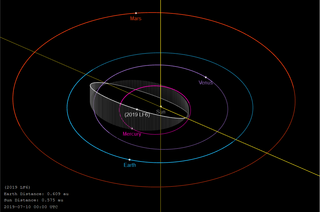
2019 LF6 is a near-Earth object of the Atira group. After 2021 PH27, it has the second-smallest semi-major axis among the known asteroids (0.555 AU), beating the previously-held record of 2019 AQ3. It orbits the Sun in 151 days.

594913 ꞌAylóꞌchaxnim (provisional designation 2020 AV2) is a large near-Earth asteroid discovered by the Zwicky Transient Facility on 4 January 2020. It is the first asteroid discovered to have an orbit completely within Venus's orbit, and is thus the first and only known member of the eponymous ꞌAylóꞌchaxnim (informally named Vatira before its discovery) population of Atira-class asteroids. ꞌAylóꞌchaxnim has the smallest known aphelion and third-smallest known semi-major axis among all asteroids. With an absolute magnitude approximately 16.2, the asteroid is expected to be larger than 1 km in diameter.
2016 NL56 (also written 2016 NL56) is a near-Earth object (NEO) and a potentially hazardous object (PHA), meaning that it has an orbit that can make close approaches to the Earth and large enough to cause significant regional damage in the event of impact. It is an Apollo asteroid, meaning that it is an Earth-crossing asteroid that has an orbit larger than the orbit of the Earth. It was first observed on 12 July 2016, when the asteroid was more than 1 AU from Earth and had a solar elongation of 163 degrees.
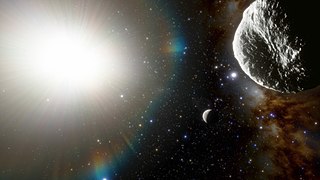
2021 PH27 is a near-Earth asteroid of the Atira group. It was discovered by Scott Sheppard using the Dark Energy Survey's DECam imager at NOIRLab's Cerro Tololo Inter-American Observatory on 13 August 2021. 2021 PH27 has the smallest semi-major axis and shortest orbital period among all known asteroids as of 2021, with a velocity at perihelion of 106 km/s (240,000 mph). It also has the largest value of the relativistic perihelion shift, 1.6 times that of Mercury. With an absolute magnitude of 17.7, the asteroid is estimated to be larger than 1 kilometer (0.6 miles) in diameter.
2023 WK3 is a near-Earth object of the Atira group.
















